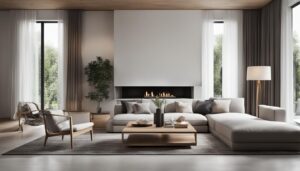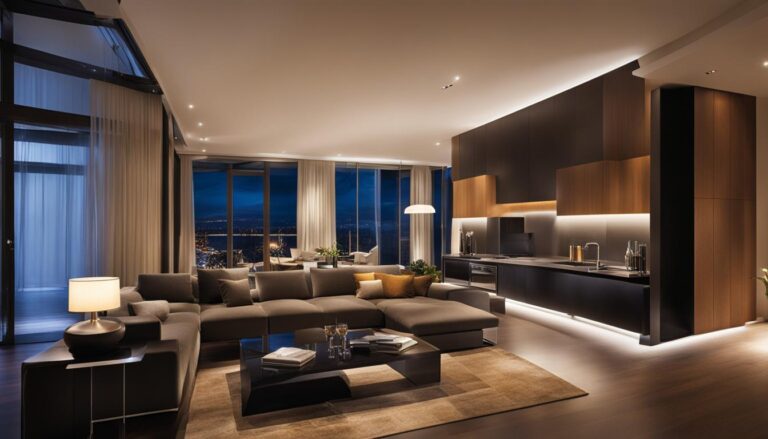Scandinavian interior design is a style that perfectly combines aesthetics and functionality, creating spaces that are both visually appealing and practical. Inspired by the minimalistic principles of design, Scandinavian interiors are characterized by clean lines, natural materials, and a focus on simplicity.
Scandinavian design aesthetics emphasize decluttering and minimalist decor strategies, creating harmonious and clutter-free spaces. The use of neutral color palettes and natural textures adds warmth and simplicity to the interiors, while the incorporation of simple, clean lines gives the space a sleek and uncluttered look.
The principles of minimalism are integral to Scandinavian interior design, as they prioritize the use of only essential items and promote a sense of calm and tranquility. By embracing Scandinavian design, you can transform your home into a haven of beauty and functionality.
Key Takeaways:
- Scandinavian interior design focuses on simplicity, functionality, and aesthetics.
- It emerged in the mid-20th century and continues to be one of the most popular interior design styles.
- Influenced by art movements such as Art Nouveau and modernism, Scandinavian design embodies natural and minimalist principles.
- Key elements of Scandinavian interior design include minimalism, natural textures, neutral color palettes, and clean lines.
- Incorporating warm textiles, functional storage, and nature-inspired elements can help achieve a Scandinavian design aesthetic in your home.
Historical Influences on Scandinavian Design
The development of Scandinavian design can be traced back to the late 19th century and early 20th century, during a time when new art movements were challenging traditional design norms. Two significant influences on Scandinavian design during this period were Art Nouveau and modernism.
Art Nouveau, with its emphasis on nature-inspired motifs and fluid shapes, greatly impacted the aesthetics of Scandinavian design. This artistic movement celebrated the beauty of the natural world and sought to incorporate organic forms into design. Scandinavian designers embraced the flowing lines, intricate patterns, and motifs inspired by flora and fauna. This infusion of nature into design became a defining characteristic of Scandinavian interior design.
“Scandinavian designers drew inspiration from the natural world, incorporating organic forms and motifs inspired by flora and fauna.”
Modernism encouraged designers to break away from conservative and traditional styles, promoting simplicity and functionality. Scandinavian designers embraced the principles of modernism, adopting a minimalist approach and focusing on clean lines and practicality. This movement marked a departure from ornate and elaborate designs, aligning with the Scandinavian philosophy of embracing simplicity and functionality in everyday life.
These influences from Art Nouveau and modernism laid the foundation for the minimalist and nature-inspired approach that defines Scandinavian interior design. By blending elements of nature, simplicity, and functionality, Scandinavian designers created a unique aesthetic that continues to captivate and inspire people around the world.
Key Elements of Scandinavian Interior Design
Scandinavian interior design is characterized by certain key elements that define its aesthetic. One of these elements is minimalism, which focuses on decluttering and keeping only what is essential in a space. By eliminating unnecessary decorations and furnishings, minimalist decor creates a clean and uncluttered environment that promotes calmness and tranquility.
Incorporating natural textures is another hallmark of Scandinavian design. Materials such as wood, stone, and brick are commonly used to add warmth and texture to interiors. These natural elements evoke a sense of connection to nature and create a cozy and inviting atmosphere in the space.
A neutral color palette is also characteristic of Scandinavian interior design. Whites and light tones dominate the color scheme, creating a bright and airy atmosphere. The use of neutral colors allows for versatility and creates a timeless backdrop that can easily be accessorized with pops of color or different textures.
Finally, simple clean lines are at the core of Scandinavian design. Furniture and decor featuring sleek, unadorned lines contribute to the minimalist aesthetic and create a sense of harmony and order. The emphasis on clean lines also enhances the functionality of the space, allowing for smooth movement and uncomplicated visual appeal.
| Key Elements of Scandinavian Interior Design |
|---|
| Minimalist decor |
| Natural textures |
| Neutral color palette |
| Simple clean lines |
Incorporating Scandinavian Design in Your Home

To achieve a Scandinavian design aesthetic in your home, there are several decorating ideas you can incorporate. Adding warm and cozy textiles, such as wool and sheepskin throws, can create a cozy and inviting atmosphere.
Functional storage solutions, such as shelves and baskets, not only help keep the space organized but also serve as stylish decor pieces.
Bringing nature indoors through the use of plants and natural elements can further enhance the Scandinavian design style.
By incorporating these ideas, you can create a harmonious and visually pleasing Scandinavian-inspired space.
A Table of Scandinavian Decorating Ideas
| Decorating Ideas | Description |
|---|---|
| Warm and Cozy Textiles | Adding wool and sheepskin throws to create a cozy and inviting atmosphere. |
| Functional Storage Solutions | Using shelves and baskets as storage options that also serve as stylish decor. |
| Nature-Inspired Elements | Bringing in plants and natural materials to enhance the Scandinavian design style. |
Table: Decorating ideas for incorporating Scandinavian design elements in your home.
The Timelessness of Scandinavian Design

One of the remarkable aspects of Scandinavian interior design is its timelessness. The simple and clean aesthetic of Scandinavian design makes it a versatile style that can seamlessly blend with different eras and other design styles. The focus on functionality and minimalist principles ensures that Scandinavian design remains relevant and attractive over time. Its ability to adapt to various design trends while maintaining its essence of simplicity and beauty makes Scandinavian design a timeless choice for creating elegant and functional interiors.
Durability and Adaptability
The timeless design of Scandinavian interiors can be attributed to their durability and adaptability. The use of high-quality materials, such as solid wood and sturdy textiles, ensures that Scandinavian furniture and decor pieces stand the test of time. These pieces can withstand daily wear and tear, making them a long-lasting investment for homeowners.
Additionally, the versatile design style of Scandinavian interiors allows them to effortlessly blend with different design aesthetics and eras. Whether it’s a traditional farmhouse or a modern apartment, Scandinavian design brings a touch of elegance and simplicity to any space, creating a cohesive and inviting atmosphere.
Simplicity and Minimalism
The simple aesthetic of Scandinavian design plays a significant role in its timelessness. Scandinavian interiors embrace a minimalistic approach, focusing on decluttering and keeping only what is essential. This simplicity creates a sense of calm and tranquility, making the space timeless and soothing for both residents and visitors.
The minimalist principles of Scandinavian design also contribute to its timelessness. By avoiding excessive ornamentation and unnecessary embellishments, Scandinavian interiors maintain a clean and uncluttered look. This minimalist approach ensures that the design remains relevant and visually pleasing, regardless of current design trends.
Functionality as a Key Element
Functionality is a cornerstone of Scandinavian interior design. Every element of the space is carefully considered to serve a purpose and enhance the overall functionality of the room. This functional approach ensures that Scandinavian interiors remain practical and user-friendly, regardless of evolving design trends.
By prioritizing functionality, Scandinavian design avoids the pitfalls of fleeting trends and instead focuses on creating timeless spaces that stand the test of time. The emphasis on practicality and efficiency makes Scandinavian interior design a reliable choice for homeowners seeking a long-lasting and versatile aesthetic.
Case Study: Timelessness in Scandinavian Design
| Design Element | Timeless Approach | Trendy Approach |
|---|---|---|
| Color Palette | Neutral tones, such as whites, grays, and earthy hues | Bold and vibrant colors |
| Furniture | Clean lines, functional designs | Elaborate and ornate detailing |
| Materials | Natural materials, such as wood and textiles | Synthetic materials, futuristic designs |
Note: The table above showcases a comparison between the timeless approach of Scandinavian design and the trendy approach of other design styles. This further highlights the enduring appeal of Scandinavian interiors.
In conclusion, the timelessness of Scandinavian design lies in its versatile style, simple aesthetic, and focus on functionality and minimalism. By incorporating Scandinavian design principles in your home, you can create elegant and functional spaces that transcend fleeting trends, ensuring a timeless allure that will continue to inspire for years to come.
Conclusion
Scandinavian interior design beautifully combines aesthetics and functionality to create harmonious and visually pleasing spaces. With its roots in art movements such as Art Nouveau and modernism, Scandinavian design embraces a minimalistic approach and nature-inspired aesthetics. By focusing on simplicity, natural materials, and clean lines, this design style has gained popularity in creating elegant and clutter-free interiors that stand the test of time.
By incorporating Scandinavian design principles and elements into your home, you can achieve a timeless and inviting atmosphere that promotes both relaxation and productivity. Embracing minimalism and decluttering your space will allow for a sense of calm and order, while incorporating natural textures like wood and stone adds warmth and visual interest. Opting for a neutral color palette creates a bright and airy ambiance that is both soothing and versatile.
Scandinavian interior design fosters a connection to nature and brings the outdoors in. You can introduce nature-inspired elements like indoor plants, floral patterns, and organic shapes to infuse your home with a sense of life and vitality. Additionally, investing in functional storage solutions helps maintain an organized and tidy space, ensuring that your Scandinavian-inspired interiors remain both aesthetically pleasing and practical for your everyday needs.
In summary, Scandinavian design offers a timelessly appealing style that balances aesthetics and functionality. By embracing the principles of simplicity, natural materials, and clean lines, you can create a beautiful and inviting living environment that reflects the essence of Scandinavian interior design.
Frequently Asked Questions
What is Scandinavian interior design?
Scandinavian interior design is a style that focuses on simplicity, functionality, and aesthetics. It incorporates clean lines, minimalism, and natural materials to create harmonious and clutter-free spaces.
What are the historical influences on Scandinavian design?
Scandinavian design is influenced by art movements such as Art Nouveau and modernism. These movements challenged traditional design norms and encouraged simplicity, functionality, and nature-inspired aesthetics.
What are the key elements of Scandinavian interior design?
The key elements of Scandinavian interior design include minimalism, natural textures, a neutral color palette, and simple clean lines.
How can I incorporate Scandinavian design in my home?
You can incorporate Scandinavian design in your home by adding warm and cozy textiles, using functional storage solutions, and bringing nature indoors through the use of plants and natural elements.
Why is Scandinavian design considered timeless?
Scandinavian design is considered timeless because of its simple and clean aesthetic, adaptability to different design trends, and focus on functionality and minimalism.











